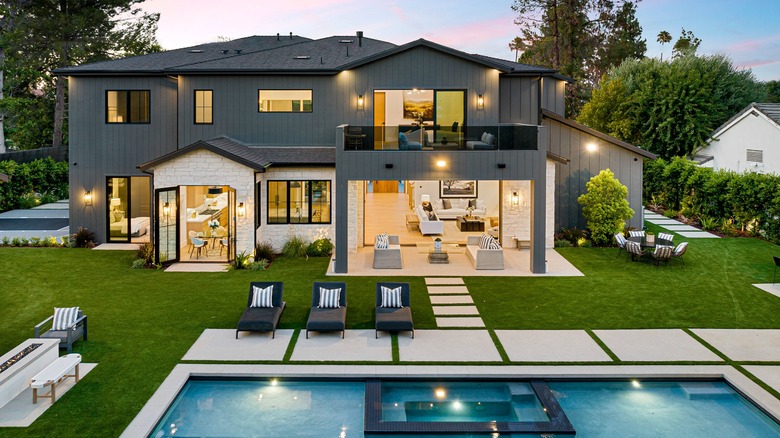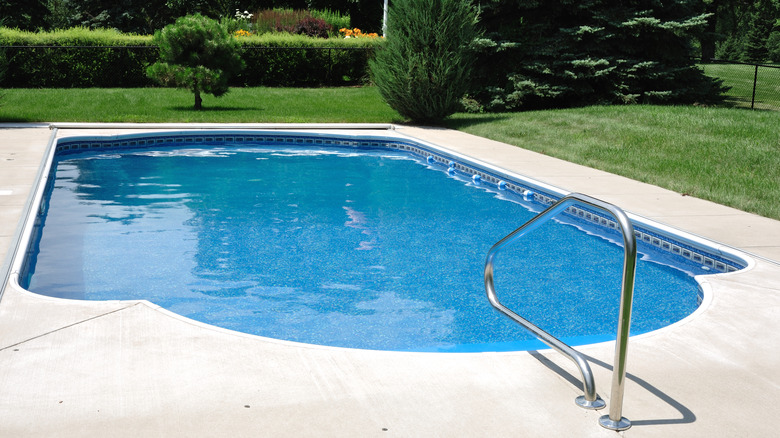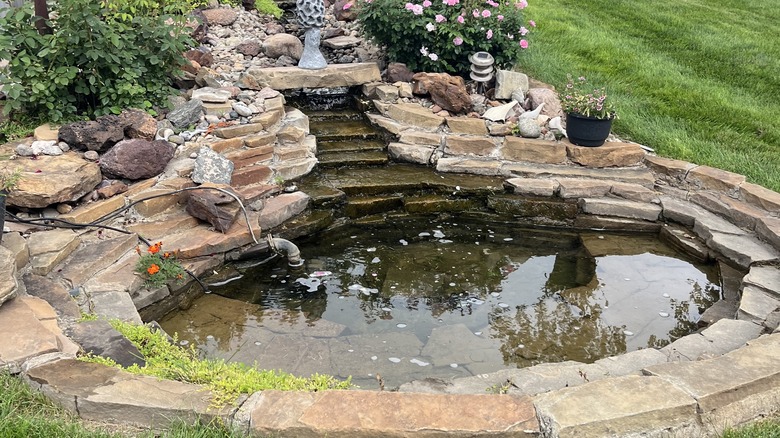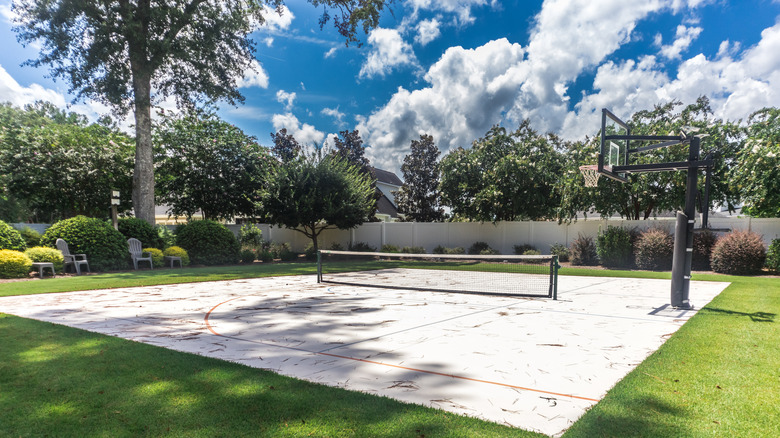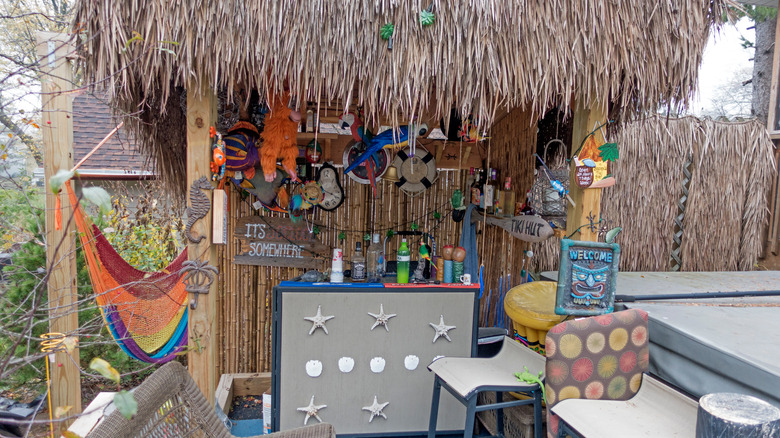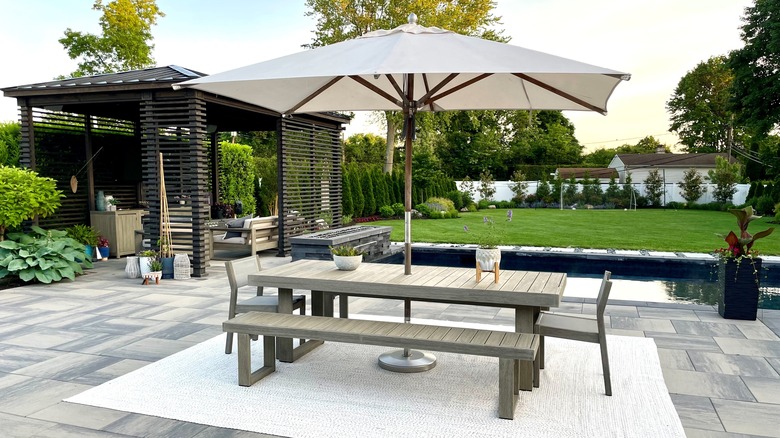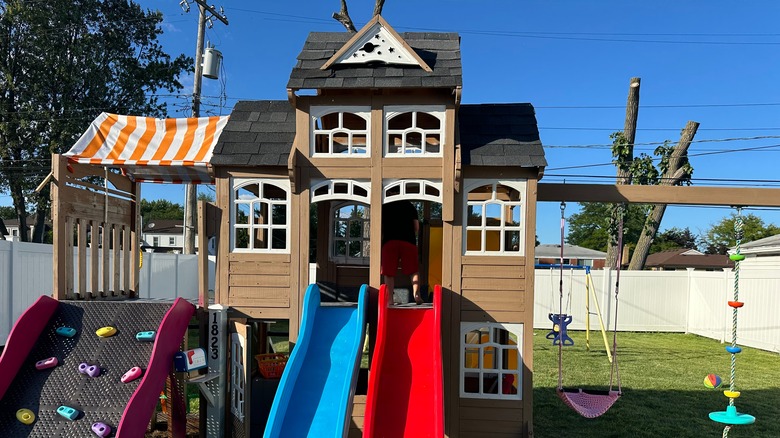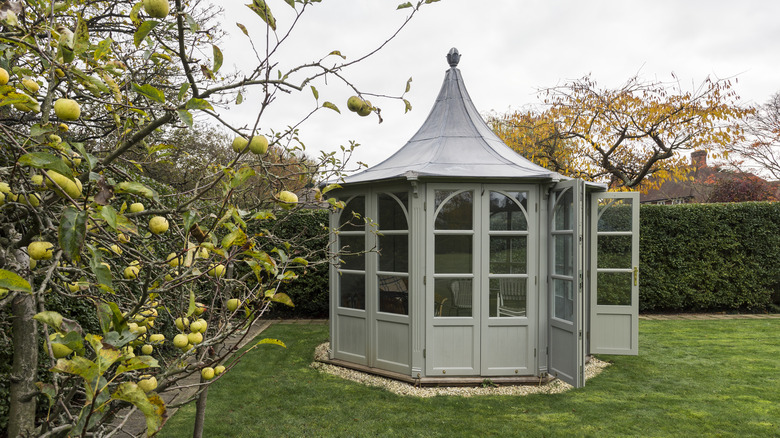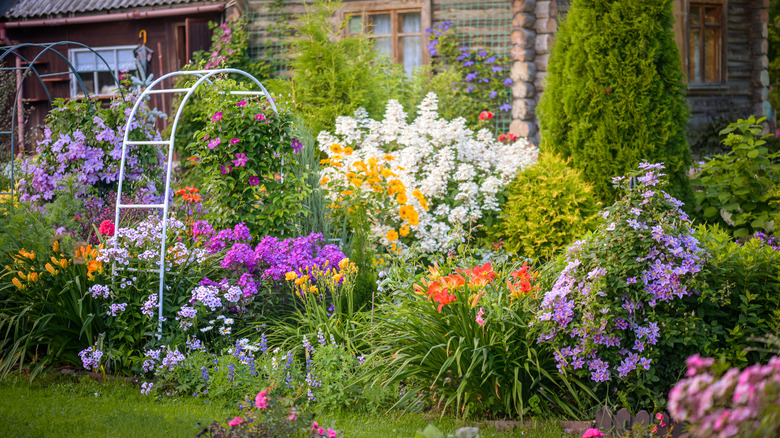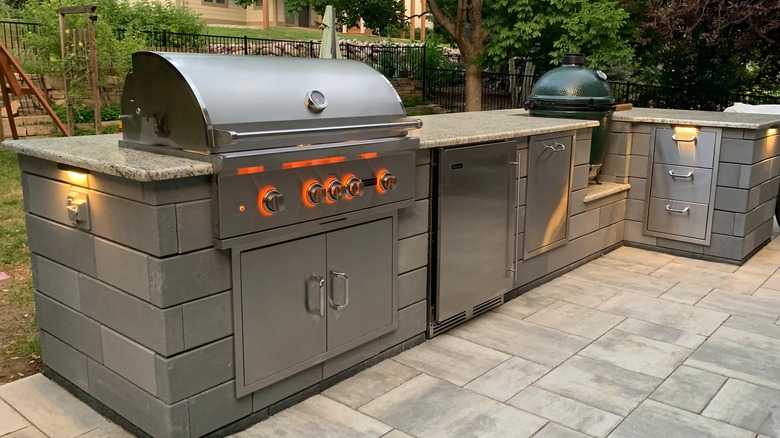Backyard Design Choices That Are Making It Harder For You To Sell Your House
We may receive a commission on purchases made from links.
If you're getting ready to put your home on the market, there are several things to think about — such as making sure it has the curb appeal to attract potential buyers, ensuring that the living room is staged properly to make it look bright and spacious, and adding some finishing touches to give the kitchen a modern and upgraded feel. However, there is one area that several overlook as they prepare to list their home: the backyard. And, depending on how it is designed, it could make it harder for you to find a buyer.
"A backyard that's too unique or poorly maintained can be as off-putting as a book with an unreadable cover — it might hide the true potential within. Keeping the design simple, adaptable, and well-kept is the secret to allowing home hunters to envision their own lifestyle unfolding in that space," Paul Herskovitz, the founder and CEO of Discount Lots, tells House Digest during an exclusive interview. To ensure you get the highest bids, Herskovitz and other real estate experts identified some backyard design choices that can hinder your ability to sell your home. Ahead, you can learn more about what to avoid and what you can do to make your backyard more attractive to potential buyers.
Swimming pools may turn off potential buyers
When deciding whether to install a pool in your backyard, there are a lot of things you should consider. Beyond your own personal comfort and preferences, you'll also want to consider the fact that this backyard addition could end up turning away potential buyers. Unless you live in a very hot climate where many people seek homes with cool and refreshing pools, Sebastian Frey, a broker associate at Compass Silicon Valley, cautions that homes with this type of water feature can actually be more difficult to sell. "There are many reasons for this — they take up a lot of valuable space, they are expensive to maintain and operate, use a lot of water which is an increasingly important concern, and of course, they are very dangerous, especially for young children," he explains.
Phil Green, the CEO of I Buy SD, agrees with Frey's assessment. He predicts that trends will soon shift away from full-size pools. "Instead of a full-on swimming pool, I have seen some homes that are putting in plunge pools, and even lounge pools. This is going to allow [individuals] to still get the benefits of having a wet space in your backyard, while not having to take on the full lift of owning a swimming pool." If you haven't put this type of water feature in your outdoor space yet and want to keep your home easier to sell in the future, it may be worth considering one of these alternative options.
If purchasers don't want to deal with the added expense, necessary upkeep, or potential safety hazards presented by your backyard swimming pool, they're going to be calculating the extra cost of having it removed, and might simply walk away from your home. Should you decide you need to have the pool removed to draw in more buyers, then you could spend upwards of $5,000 to do so.
Large water features can cut into the open space that buyers desire
While large water features have the potential to beautify a backyard, they aren't something that all home seekers want. And, even more than this, many buyers may get turned off by these features, leaving them to walk away from the home or offer less money. "Koi ponds, artificial streams and waterfalls, large ornate fountains — these are things that also eat up space, require a fair amount of maintenance, and provide very limited utility in exchange," Frey explains.
Instead, Frey highlights the desire for something easy to upkeep in the backyard. Most are looking for something that won't consume much of their time. "They'll appreciate the use of native and/or drought-tolerant landscaping that doesn't require a lot of attention to keep looking good year-round — ideally without any kind of irrigation required."
If you still want water features in your yard for your personal enjoyment while living in the home, there are ways you can get the best of both worlds. For instance, looking for smaller and less permanent fixtures will allow you to enjoy the calming and relaxing environment it creates without alienating future buyers. One idea to consider is a large bird bath with a small fountain that can deliver that pleasant sound of splashing water while encouraging feathered friends to stop by. The VINGLI Antique Copper Bird Bath with Solar Fountain is a great pick for this. Another is a mini pond in a standalone container, like the Aquascape AquaGarden. Both of these options can simply be drained and taken with you when you move, leaving the yard more open for the new owners.
Sports courts are unlikely to make your home attractive to many
If you've been asking questions like, "Does having a tennis court add value to my home?" you might be surprised by the answer. Frey explains that sports courts, such as those for basketball or tennis, are not something most buyers are looking to have in their backyard. "They are generally unattractive concrete or asphalt slabs that pave over earth that many potential buyers would prefer to see as a lawn, garden beds, or perhaps some kind of orchard," he explains. So, even if you are an avid tennis player or your children are aspiring basketball stars, you might want to rethink adding your own personal court and stick to community use areas.
If it's absolutely necessary for you or your kids to have a place to shoot hoops or practice your swing in your backyard, try interlocking tiles like the Playsafer Brick Rubber Tiles. These can be installed outdoors, over flat areas of grass or soil, to create a temporary sports court. When you are ready to sell, you can disassemble them, pack them up, and take them with you to your next destination.
If your yard is overly personalized, potential buyers may not be able to envision the space as their own
While you want your backyard to be a good reflection of your personality and interests, making it too personalized may prove to be a serious mistake when you're ready to sell your home. "Buyers need to be able to picture the space as their own. Specialized backyard features can make that difficult," Carissa Kristoff, a realtor at C Kappa Corp/ Berkshire Hathaway HS Select Properties, tells House Digest in an exclusive interview. If the landscaping and design choices are overly eccentric or kitschy, those who tour your home might not be able to get a clear picture of how they will be able to use the space, which ultimately could cause them to reconsider making an offer on your property.
To avoid this potential problem, Herskovitz advises to "go with a neutral and versatile design instead of one that is shouting personality." He continues: "Think soft landscaping, paint and simple, comfortable patio furniture, allowing buyers to envision how they might put their own personal stamp on the space." So trade in the themed furniture for something simpler, like the Grand Patio Store 7-Piece Wicker Set. Vice President of Sales at Awning: A Real Estate Investing Company, Andreis Bergeron, seconds that strategy. "This more universal design both reduces the need to renovate immediately and welcomes prospective buyers to envision their own lifestyle unfolding in the space."
Excessive hardscaping can make your backyard uninviting
Your neighbors may hate certain landscape features that you add to your yard, including excessive hardscaping. While you might not care what your neighbors think, they aren't the only ones who may find too much concrete unattractive: You could also end up scaring off potential buyers. "If the entire backyard is covered in concrete or pavers with no green space left, it limits what a buyer can do with the area. People want flexibility," Larry Shinbaum, a real estate agent and broker at Luxuri International, tells House Digest in an exclusive interview.
"A better option is balancing hardscape and landscape, keeping some open space for the next owner to make it their own," he explains. As you're planning the space, there are a few things you can keep in mind to help you ensure this more balanced approach. One idea is to have the same ratio of lush gardens and lawns and patios and concrete fixtures. You can also take measures to soften any hardscaping features to make them feel less harsh. Adding flowers or shrubs along the sides of a walkway or the edges of a patio, for example, can create a more seamless flow into the green space surrounding it. Ultimately, Michael McGuirk, a licensed real estate agent with Sotheby's International Realty, stresses the importance of ensuring that your yard has ample green space. "Having a well-defined and healthy lawn appeals to prospective homeowners. One with a small play area with grass or soft mulch can even open up the pool of buyers and attract families," he notes.
Large children's equipment will have buyers questioning high removal costs
If you have young children, you may be considering having a large playset installed in your backyard. While this may ultimately prove to be the right choice for your family, there are some important things you should consider before proceeding with this large and costly project. Beyond the potential for a child's playhouse to attract wasps, these larger structures and equipment may send potential buyers away.
Purchasers are going to do some research on the costs of removing the equipment, and they may not like what they find. Beyond the initial investment of up to $1,000 to have the playset disassembled and removed, they'll also be calculating the cost of rejuvenating the dead grass under the structure. If it is necessary to lay sod, for example, it could potentially cost them a few hundred dollars more. If you decide a playset is the right choice for your family, you might want to start budgeting for its removal before you plan to put your house on the market so buyers don't need to worry about it.
Structures that dominate the yard can be a turn-off
If you're adding any permanent structures to your outdoor space, think carefully about the potential impact they'll have when it comes time to sell your home. Shinbaum cautions against installing anything overly large. " A giant gazebo or a custom fire pit that takes up half the yard might seem like a great idea, but if it dominates the space, it can turn buyers off," he explains. Remember, when a potential buyer is viewing your property, they are trying to envision themselves living there. And, one thing that many want to see is ample green space where their children can play, where their pets can run around, or where they can customize the yard to fit their personal preferences. If much of the space is consumed by one or more permanent structures, it's going to be all the more difficult for buyers to visualize the space as their own.
Fortunately, some slight modifications to your plans can help you get much of what you were envisioning without sending buyers running away. "Instead, go for versatile features like a well-placed pergola or a portable fire pit that enhances the yard without making it feel locked into one layout," advises Shinbaum. For the latter, such an example is the Solo Stove Bonfire Stand, which weighs only 20 pounds but can seat 4 to 6 people.
Few buyers are looking for homes with high-maintenance plants
You may be wondering if gardens can increase the value of your home. While this is possible, it isn't always the case. It can vary based on several factors, including the specific plants you choose. McGuirk cautions against choosing any greenery that has very high care needs. "I have had one too many clients that I have shown beautiful homes to that walk away without putting in an offer because the gardens and lawn maintenance scares them. While it might look absolutely amazing, and as we know curb appeal is everything, buyers sometimes see this as a new full-time job they have to take on or an added big expense if they need to hire someone." Even if you have a bright green thumb and love spending hours of your time in the garden, it's unlikely that a potential buyer will have the same time to dedicate to caring for the plants.
So, skip this outdoor landscaping feature that simply isn't worth the investment and focus on lower-maintenance options. "Perennial plants come back year after year so that you do not need to be out there every spring replanting bulbs," shares McGuirk. This is something you could even tell potential buyers — they're likely to appreciate the prospect of a blooming flower bed without much or any effort on their part. McGuirk also recommends ensuring that you choose native plants for your region. Doing so, he explains, should provide you with even greater confidence that they won't need much care from you and that they'll thrive in your climate without taking over.
An expansive outdoor kitchen might be seen as overkill
While an outdoor kitchen has the potential to make your home more appealing to potential buyers, things could easily go the other way if you make the wrong choices when setting everything up. According to McGuirk, going over-the-top when designing and outfitting your deck or patio kitchen probably isn't the best idea if you want to attract more buyers. "While an elaborate outdoor kitchen with all the bells and whistles and updated appliances might have worked great for you as you honed your 'Iron Chef' skills, it can feel excessive to buyers who won't use it." Again, think about how much of the yard your setup is taking up. If it is all-consuming with built-in seating, several outdoor appliances (such as a fridge or even a dishwasher), and lots of paved or covered surfaces, open house guests are likely to long for more of an actual yard — with space to run and play.
After evaluating the potential downsides to building an outdoor kitchen, the choice will ultimately be up to you. If you are not planning on selling any time soon and have your heart set on creating a cooking oasis, then you'll have to be prepared for the pushback you may get down the line from buyers. If your plans are a bit more flexible, consider McGuirk's suggestion. He says, "Instead, a simple outdoor kitchen or built-in barbeque can add appeal, especially if there is a nice designated dining area with space for a table and chairs that they can adapt to their 'tastes.'"
